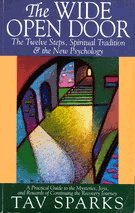The Wide Open Door: The Twelve Steps, Spiritual Tradition, and the New Psychology

Chapter headings:
- Introduction – at another turning point
- 1. At the crossroads – is this all there is?
- 2. Good news – doing it right
- 3. New ideas – living in a different world
- 4. Back to the source – the power beneath the steps
- 5. New maps – the wave and the ocean
- 6. The treasure trove – eleventh step doorways
- 7. Surrender – the mystery of death and rebirth
- 8. The fruits – experiences of wholeness
- 9. Stepdance – the twelve steps as a Western yoga
- 10. Recovery as Tao – how this way works
- 11. The Big Twelfth Step – recovery and the planet
Selected excerpts:
“The most profound and all-encompassing metaphor for addiction and recovery is so old that it is almost new. This universal definition is to be found in Buddha’s Four Noble Truths. The First Truth states that life contains suffering. The Second explains that suffering is caused by craving, attachment, and unfulfilled desire. As we said previously, our modern word for this craving, or attachment, is addiction. The Third Truth lets us know that there is a way out of suffering. And the Fourth demonstrates what the way out is by outlining the Eightfold Way.”
“The Four Truths directly relate to the Twelve Steps. Accepting the truth of suffering, and that suffering is caused by addiction, is the action of the First Step. That there is a way out falls under the domain of the Second. And the Fourth Truth, or the Eightfold Way, corresponds to the rest of the Steps and “how recovery works.”
“The Buddha’s description of the basic problem of human suffering as attachment demonstrates that addiction is a universal human dilemma. The fact that the Steps are devoted to the alleviation of this condition, in the same fashion that the Buddha prescribed the practice of the Eightfold Way, elevates the Steps once more to the ranks of the great traditions of the world. As the recovery metaphor evolves, we can look to the future for new definitions. But ironically, one of the newest requires us to look back into the distant past. There we discover that one of the greatest thinkers of our planet, the Buddha, was also the first true recovery pioneer.” (pp. 200-201)
© 1993 Tav Sparks
Order this book online at Amazon
Reviews posted:
Paul –
The Wide Open Door, first published in 1993, is specifically targeted at Twelve Step practitioners who have reached a ‘crossroads in their recovery’ (who find they are asking themselves the question “Is this all there is?”). He offers some means to revitalize and deepen the work of the Steps, by placing them in the broader context of other spiritual traditions. He also surveys a wide variety of Eleventh Step practices. The book is similar in subject matter and tone to Christine Grof’s. Given the emphasis on Eleventh Step practices I was initially disappointed that meditation warranted only a few pages, yet he does devote a number of pages to Buddhism and describes the Buddha as “the first true recovery pioneer”. His examination of the Steps in the context of yoga is interesting, and is still a point of difference versus other publications. Like much of the Buddhism and recovery literature I found the outlook to be unmistakably Californian (intended more as an observation than a negative comment!)
Michael –
In his book The Wide Open Door, Tav Sparks asks the question “Is this all there is?” and helps those at the crossroads explore new avenues, particularly those for whom “recovery feels more like the absence of pain than the addition of joy”. Drawing on the wisdom of some of the world’s great spiritual philosophies as well as Jungian and transpersonal psychology, he offers a variety of further avenues to both enrich and ultimately deepen one’s Twelve Step work. I found his exploration of various spiritual traditions quite good and it is in these areas that I felt he was most potent, though Buddhism and meditation are covered only briefly. His use of Jungian and transpersonal psychology however, though similar in subject matter to Christine Grof, I felt lacked her ability to more immediately and intimately connect with the reader. At times he seemed to cross over into what I would consider quite alternative “new-age Californian” techniques, which I personally found unfortunate. Nonetheless, he addresses and explores what I believe is quite a typical crossroads that many of us in recovery reach, and by his own admission offers this exploration “not as the truth, but as one way to consider the Twelve Step adventure.” Having reached a crossroads myself, my Buddhist practice now provides the context for further work. But for those interested in a broader combination of spirituality and psychology as a way to further explore recovery, then this book does provide a number of potential paths to explore. You can always take what you like, and leave the rest behind.
